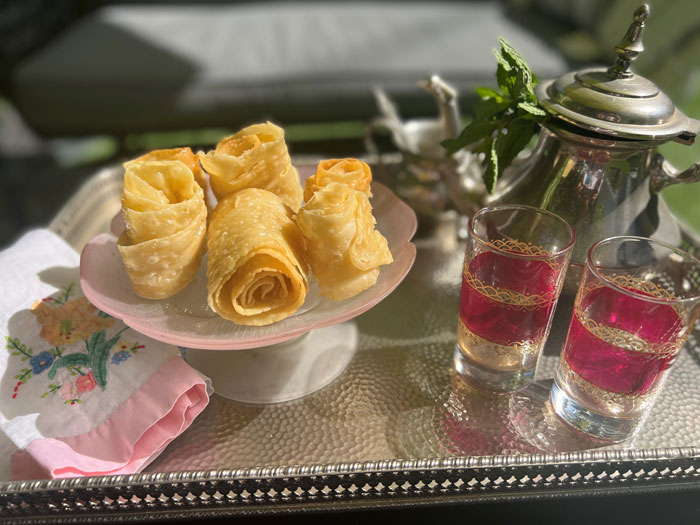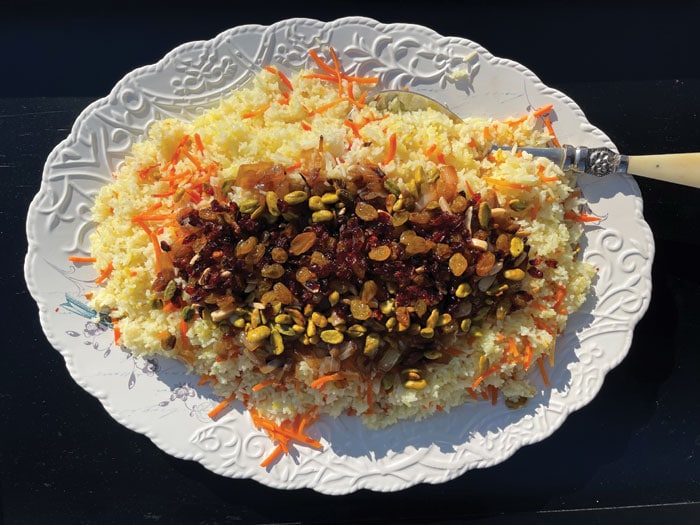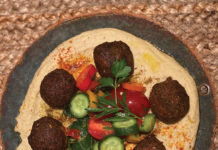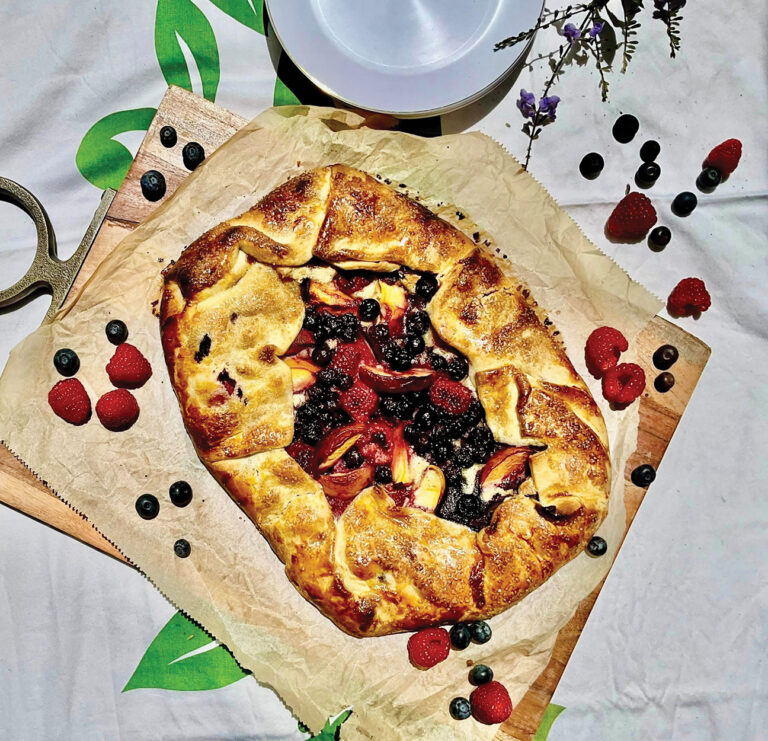A Date with a Purim Destiny and The Rolled Up Sweetness of Fijuelas
Ba’ba tamar are the best treat you’ve probably never had—a thin four inch round cookie made with a crispy, unsweetened dough and a soft, chewy date filling.

“Sharon! Your grandmother’s cookies!!” was the excited direct message from our friend Ruth when she saw our Instagram post about the upcoming Sephardic Spice Girls Iraqi Master Bake Class.
In those few words, she telegraphed so much. You see, my grandmother Nana Aziza made the most incomparable, most delectably tasty ba’ba tamar. Ba’ba tamar are the best treat you’ve probably never had—a thin four inch round cookie made with a crispy, unsweetened dough and a soft, chewy date filling. About 30 years ago, Ruth and her husband Todd were initiated into the fan club of my grandmother’s delicious baking.
In our family, my grandmother’s ba’ba tamar were highly prized (and jealously guarded). On baking days, she would start early. She would proof the yeast and mix it with the flour, oil and water. She would knead the dough until it was a wonderfully soft, stretchy texture. She would cover it with a muslin cloth and let it rest, like a precious baby. She would soften the pitted date paste with a bit of oil and in her own untraditional take on the recipe, she would add crushed walnuts.
WATCHING HER OILED HANDS WORK THE DOUGH AND DATES WAS LIKE WATCHING A MAGICIAN AT WORK.
Watching her oiled hands work the dough and dates was like watching a magician at work. Roll the dough into balls. Roll the date mixture into balls. Press the dates into the middle of the dough and make it disappear. Take the wooden rolling pin and flatten the dough into a perfectly round cookie with no date filling breaking through the thin crust of the cookie. Turn the end of the rolling pin and make four indentations in the center. Brush with the egg wash and sprinkle sesame seeds on top.
Then the cookies would be lined up on baking sheets and placed in a warm oven. The cookies had to be watched with a hawkish eye — too little time in the oven would result in a pale doughy cookie, too long and they’ll have the texture of a hard brick.
My grandmother would pack the cookies in brown paper bags to give to her children and grandchildren. The rest would be stored in a big airtight container to serve to guests with a cup of her cardamom scented mint tea.
Every year before Purim, there is a community bake at Kahal Joseph, with grandmothers teaching their children and grandchildren how to make traditional Iraqi pastries — cheese sambusak (dough pockets stuffed with feta cheese), malfouf (flaky filo pastry cigars filled with crushed walnuts), crispy almond macaroons and, of course, ba’ba tamar.
This year, Rachel and I were determined to do a Purim baking class to empower women (and ourselves) to make these seemingly complicated recipes. Two weeks ago, we had a Sephardic Spice Girls Master Bake at Kahal Joseph. Yvette Dabby, the President of Kahal Joseph, her sister Rosie Nissan, Orly Kattan and other volunteers made a massive amount of dough, date filling and cheese filling to facilitate the Bake.
Yvette, who left Iraq in 1971 with her husband Joe and a degree in architecture, explained that in Baghdad, all the women would gather together to bake for Purim. They would arrange the treats on silver trays and give them as Mishloach Manot.
The evening was a huge success with over sixty women (and a few intrepid gentlemen) happily learning to make ba’ba tamar and cheese sambusak.
Rachel and I saved a dozen ba’ba tamar for Ruth. — Sharon
Sharon’s Ba’ba Tamar Recipe
Date Filling
2 cups pitted dates
1/4 cup olive oil
3 tablespoons water
1/4 cup crushed walnuts
In a frying pan, over very low heat, combine dates and olive oil. Stir for 5 minutes until the date mixture is soft. Add water and walnuts and stir until it becomes a smooth paste.
Set aside to cool.
Garnish
3 eggs
1 tablespoon honey
1 tablespoon water
1/2 cup sesame seeds
In a small bowl, beat together the eggs, honey and water. Set aside.
- Dough Recipe
2 packets active dry yeast
1 tablespoon sugar
1 teaspoon kosher salt
2 cups warm water, divided
7 cups all purpose flour, sifted
1 cup avocado or vegetable oil
1 teaspoon fennel seeds - In a small bowl, add warm water to yeast, sugar and salt. Cover and leave to proof for 10 to 15 minutes.
- In a stand mixer, add flour, oil, water, fennel seeds and yeast mixture and mix until a dough is formed.
- Remove dough from mixer bowl and knead the dough by hand until it is smooth and stretchy.
- Place the dough in an an oiled bowl, then rub some oil on top of the dough. Cover with a kitchen towel, set aside in a warm spot for 1 hour.
- Remove the dough and knead for 2 minutes. Return to the bowl and let stand for 25 minutes.
- Preheat oven to 375°F.
- Divide the dough into four pieces. Grease hands with oil, pinch the dough into golf ball size balls and roll till smooth. Lay the dough balls on a greased baking sheet.
- Place a ball of dough into the palm of your hand, make a deep indentation into the dough and place half a tablespoon of date filling in the hole.
- Pinch dough closed, dip the ball into the egg mixture, then roll in sesame seeds.
- With a small rolling pin, roll the ball flat until it is about 4 inches in diameter. With the end of the rolling pin, make a few indentations in the center of the cookie. Place cookies on a baking sheet. Repeat until all dough and date filling are used.
- Bake for 12 to 15 minutes, until golden and crispy.

Lately, I have been nostalgic for fijuelas, the fried crispy delicate sweet treat that my mother made every Purim. My mother would prepare the light dough and stand in front of the stove, quickly frying batch after batch of perfectly uniform strips of dough into rolled fijuelas. Then she would dip them into a lemon-scented sugar honey syrup. While they go by many different names—fijuelas, fazuelas, hojuelos—they are an iconic pastry common to the cuisines of Sephardic Jews from Spain to North Africa, from Italy to Argentina.
Hélène Jawhara Piner, author of “Sephardi: Cooking the History,” writes that these Sephardic treats are a recipe that dates from the late Spanish Middle Ages. They are first mentioned in a famous story, “La Lozano Andaluza.” In the 16th century, Andalusian author Francisco Delicado writes about a Jewish woman fleeing the Inquisition. Having found refuge in Rome, she tells another woman that when she lived in Andalusia, she used to prepare hojuelas.
This scholar of food and medieval history says that “their characteristic form is undeniably reminiscent of Esther’s Megillah.” She adds that Christians in Spain still eat this dessert for a special feast called Semana Santa, a holiday that always falls within days of Purim.
I will always remember my mother’s kitchen in Morocco, with every surface covered with thin strips of dough ready to fry for fijuelas. Traditionally, the dough was rolled out flat with a rolling pin and cut into long ribbons. But then the pasta machine came to Casablanca. My mother would clip hers to the side of the table, she would put the dough through with one hand, I would crank the handle for her and she would catch the thin strips of dough on the other end.
I WILL ALWAYS REMEMBER THE BIG PURIM SEUDAHS OF MY CASABLANCA CHILDHOOD.
I will always remember the big Purim Seudahs of my Casablanca childhood. The meal always included letrea, homemade egg noodles flavored with Saffron. Dessert was lots of Moroccan cookies and best of all, freshly fried fijuelas.
When I set out to make my own fijuelas, I was very surprised that twirling the dough to get the scrolled form wasn’t as easy as my mother made it look. But the more I practiced, the easier it got and by the end, my fijuelas were pretty enough.
I shared them with my family, bringing a huge smile to all their faces.
Wishing you a happy Purim with a world that is turned right side up.
Fijuelas Recipe
2 extra-large organic eggs
(break eggs open and keep the largest
half for measuring oil and water)
2 eggshells olive oil
1 eggshell water
1 eggshell orange blossom water (or plain
water)
Juice of one lemon
A big pinch of kosher salt
½ teaspoon baking powder
400g all-purpose flour (approximately 3 cups)
Almibar (Syrup)
2 cups sugar
1 cup water
I lemon, cut in quarters
8 tablespoons honey
Peel of one lemon
- In a large bowl, mix eggs, oil, water, orange blossom water, salt, baking powder and lemon juice.
- Slowly add the flour and mix well. When the dough comes together and is not sticky, stop adding flour (there may be some unused flour.
- Cover the dough with a dish towel and let stand for 20 minutes.
- Form the dough into a log and cut into 3 to 4 pieces.
- Take a piece of dough and make 2 inch wide long, thin strips, using a pasta machine or a rolling pin. Then cut the strips until they are approximately 8 inches long.
- In a large and deep frying pan, warm oil over low to medium heat.
- Pick up one end of the dough strip and insert it between the tones of a fork.
- Dip the fork and the dough into the warm oil. As the dough starts to blister, lift up the other end of the dough, slowly feed it into oil and slowly rotate the fork, wrapping the fried dough around the fork.
- Once a coiled pastry is formed, remove from the oil and place on paper towel to drain. Continue to process until all the dough strips are fried into coil shapes.
- Make the syrup by adding all the ingredients into a small pot. bring to a boil, keep stirring and when the syrup starts to thicken and feel heavy on a spoon, turn it off.
- Dip one Fijuela at a time into the syrup, and cover all sides, place on a serving platter.
- Best when eaten same day. Can be kept in a well-sealed container for a few days.
Sharon Gomperts and Rachel Emquies Sheff have been friends since high school. The Sephardic Spice Girls project has grown from their collaboration on events for the Sephardic Educational Center in Jerusalem. Upcoming events include interviewing Chef Shimi Aaron at the WIZO Purim Luncheon and a Sharsheret Passover Cooking Webinar. Follow them on Instagram @sephardicspicegirls and on Facebook at Sephardic Spice SEC






One Comment